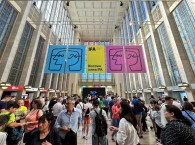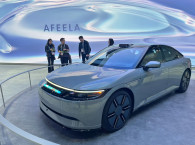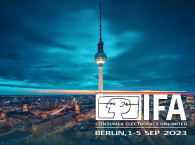With IFA fully occupying two exhibition areas, Europe's giant trade show for Consumer and Home Electronics was indeed a busy time for all technology companies and certainly for many of the key development platform vendors. Appropriately, this year's Home Appliances@IFA celebrated its 10th anniversary, reinforcing somehow what is already recognized as the largest world show for Electric Appliances. Normally the companies active in consumer electronics (CE) and appliances that dominate the Berlin show are there to promote their latest products for the upcoming holiday season. But this year I couldn't help noticing that most of the products on display were also a kind of a celebration of a vision that will not necessarily materialize until the end of the year, although they seemed to excite everyone.

But the impressive part of IFA 2018 were really the appliances - I never cease to be amazed as to how much more technology Toshiba, Bosch, Siemens, AEG/Electrolux, Philips, Samsung, LG, etc., keep adding to refrigerators, ovens, washing machines, and all sorts of cooking machines - and they are all network connected now. Everyone agrees that with less expensive sensors and more powerful distributed computing, consumer electronics will be able to collect more data than ever before - and using this data with AI makes it possible for products to evolve and to become more adaptive - more intelligent. This was the official pitch from LG Electronics and almost all the other big companies from Asia that offer everything from dishwashers to displays. All of these companies are also stepping into automotive technologies and even public transportation systems. This year, LG pitched the next step as the need to interconnect all the AI-powered devices, from air conditioning to refrigerators to autonomous vehicles. Panasonic also proudly showcased the projects it is involved in - everything from bullet trains to solar power and smart grids - before moving on to actual shipping products, introducing its latest TVs and Technics turntables. It was strange.

Even at the "innovation" IFA NEXT area, now in its second year and already doubling in size with about 200 exhibitors - around 150 of them startups - the focus was on refrigerators and laundry solutions, all sharing the same AI vision. And I should mention that in virtually every demonstration and new product presentation, a voice interface was the common factor. Everything must be voice controlled.
At IFA 2018, in every product category, there were products showing voice commands, voice recognition, and the integration with the most popular voice personal assistants such as Amazon Alexa (Amazon now claims more than 20,000 Alexa-connected products), Google Assistant, and Apple Siri. Funny enough, no one seems to talk about Microsoft Cortana any longer while Samsung seems to be testing the grounds, after unveiling a hilarious "fondue-pot" of a smart speaker, which supposedly will eventually support the company's own voice assistant, Bixby.
Whatever the voice implementation, all this is great news for the audio industry. Because every system now features an audio module of some kind. And all those systems need powerful processing capabilities for voice interfaces and embedded advanced software, and increasingly they will support Artificial Intelligence edge computing (hello Bragi), because not everything can always be connected to the cloud. This is not something that is just being powered by the mobile industry and smartphones. It actually signals a completely new front where large and small, but mostly highly specialized companies are betting heavily. Because in the same way that we already know hearables and wearables need advanced sensing, power management, and connectivity to services, the new class of appliances showcased at IFA all point in the same direction: a mesh of connected devices with distributed intelligence to power the smart home and buildings, and our own personal integration around those devices and the mobile networks - wherever we go.

For the audio industry, this can be exciting.
First, the sheer number of components and technologies, including some of the most traditional ones (e.g., speakers, microphones and amplifiers) is multiplied by a factor of thousands (or millions) to meet this expansion. Second, there's no reason why audio devices should stay away from that revolution. As we have discussed several times, loudspeakers, integrated amplifiers, full audio home hubs, and music servers need the same abilities and connectivity. It's not just about "smart speakers," but smart audio. Even the most traditional manufacturers and high-end designers need to understand this as an opportunity. Otherwise, soon the market will start considering those LG speakers with "Meridian Audio technology," as the new "high end."
This makes the Berlin show an interesting space to watch mainly due to the realizations of actual technology implementation. Not surprisingly, Berlin is where most of the development platform vendors proudly display their achievements with the major brands, while at CES in Las Vegas, NV, we need to attend meetings behind closed doors to actually see glimpses of new products and actual demonstrations. As our continuous IFA show coverage online shows, there were no shortage of announcements from those vendors (Frontier, StreamUnlimited, LibreWireless, etc.).

Among the messages from the largest brands, I particularly appreciated Sony's press event because of the refocusing on the essential. As Sony accurately highlighted, the convergence of very high-resolution imaging and real-time delivery platforms - such as the emergent 5G wireless mobile network standard(s) - enables a world of applications far surpassing entertainment (e.g., medical, security, industrial, and even applications in autonomous vehicles). When performing a critical surgery, I am certain no one would dare to claim that "maybe in HD is enough" when they have the richness of 8K imagery available... and when they can zoom in 16x the same frame and still get a high-definition picture.
Similarly, on the audio front, the concept of real-time experiences that LG, Sony, and many other companies are proposing will become a superior level of service in music streaming and all the entertainment platforms, from online content such as Netflix to online gaming in the PlayStation network. This has the potential to create a foundational platform where new multichannel and object-based audio immersive experiences will not only be practical but extremely enjoyable. And while current platforms continue to require the use of data rate reduction for real-time distribution, we are already benefiting from uncompressed audio recording and production in high-resolution and high-frequency sampling. Soon we will have enough data rates for truly lossless services, and as the evolution of audio technology in recent years has demonstrated, we are now able to manage that transmission/distribution much more efficiently.

As highlighted at IFA 2018, it will soon be possible to combine optimization techniques (e.g., variable bit rate) with the distribution for base signals such as music at the highest possible quality on which these audio sources are originated, while applying data compression to optimize "environment enriching" channels (e.g., surround channels in movies and sports) or combine it with object-based audio information in real time interactive experiences (e.g., augmented reality, gaming, and virtual reality) for entertainment, education, and scientific applications.
Even though IFA is a show designed to predominantly promote the entry-level cheaper products, on the audio front many companies highlighted more upscale home solutions, and in particular high-resolution audio products, from production tools (e.g., microphones and recorders) to Hi-Res Audio mobile players, and even smartphones from brands such as LG, Samsung, Sony, and others. There is no way of ignoring the fact that millions of consumers are now exposed to something far superior to what, in general, we assume to be available in the mainstream music streaming services and mobile devices. Best quality audio experiences is not something we identify with the IFA show in Berlin. But that exploration was the part that made this year's show enjoyable, as soon as I was done with the soundbars, smart speakers, and Alexa-enabled microwave ovens.

Statistics
IFA 2018 welcomed 245,000 visitors, including 150,000 trade visitors, of which 50% were from outside Germany. A new all-time high in international attendance. There were 1,814 exhibitors, covering 161,200 square meters of floor space. Order volumes for deals struck during IFA grew yet again, totaling 4.7 billion euros.

Register here to receive The Audio Voice weekly newsletter: http://bit.ly/1ri0b4J







